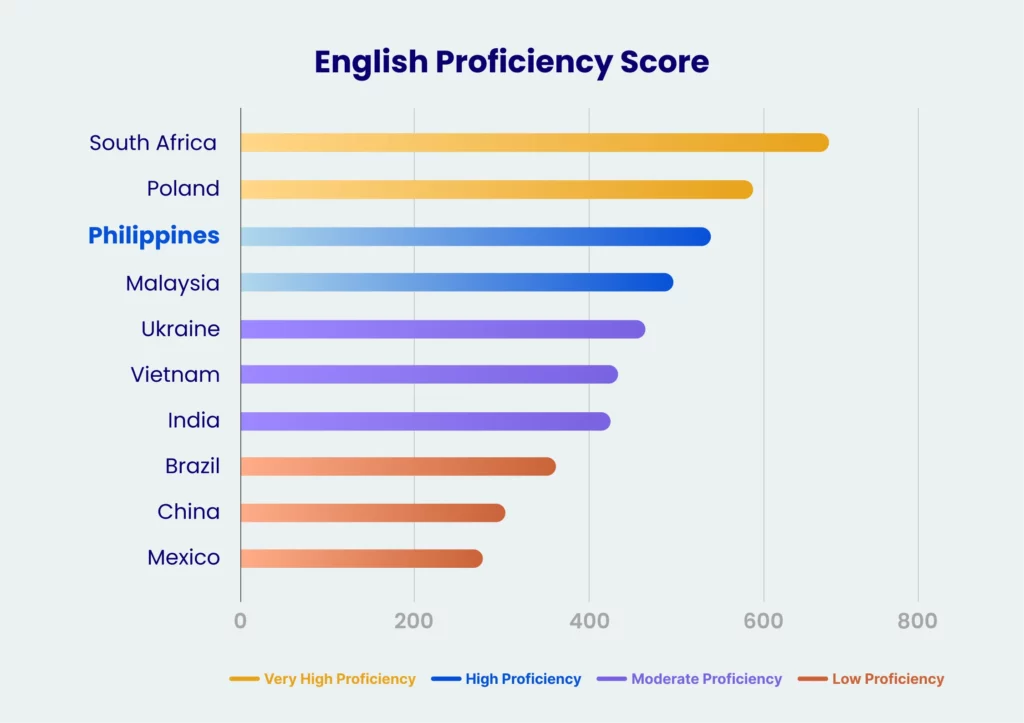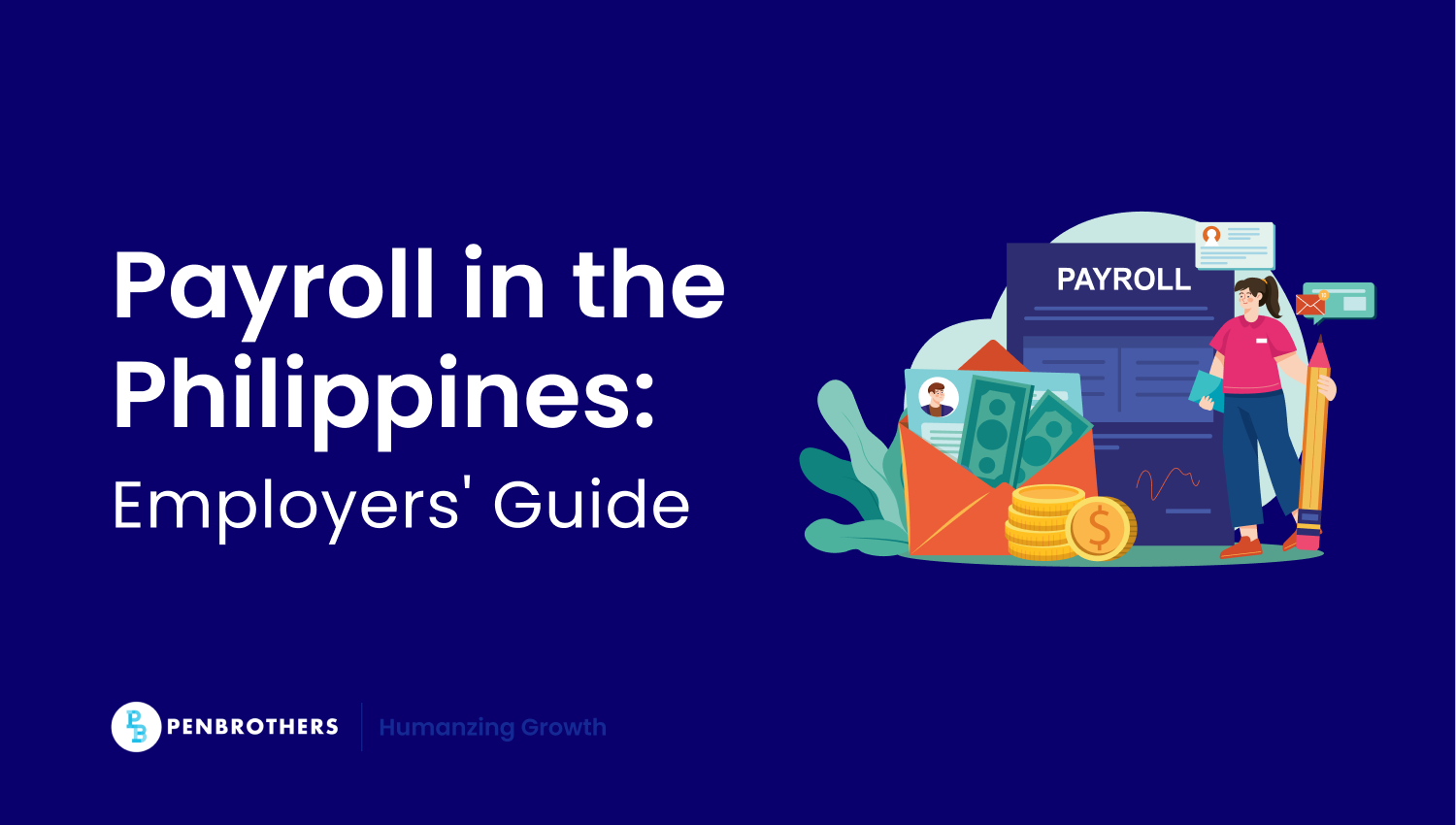What's Inside?
How the Philippines Became Asia’s English Proficiency Success Story

Do people in the Philippines speak English?
This is a common question asked by business people, especially those who know this country as a travel destination. The 2023 survey conducted by the Social Weather Station revealed that 47% of Filipinos are highly fluent English speakers.
This Southeast Asian country holds the #2 rank next to Singapore in terms of English proficiency, but remember that Singapore’s population is 6M while the Philippines has over 119M. This means over 55M Filipinos outshine Singapore’s 2M English speakers.
When it comes to English proficiency of countries that are top destinations for outsourced jobs, the Philippines also ranks higher. Here’s a comparison:

But, why is English fluency among Filipinos high? This article covers the factors that enabled this country to rank #20 worldwide in terms of English competency.
English is the Philippines’ medium of instruction.
Historically, the Philippines was colonized by the United States from 1898 to 1946. One of the heaviest influences of the Americans was integrating English into all educational systems. While Spanish and Filipino are taught in classrooms, the dominance of the English language was ingrained in society.
Even public documents like The Philippine Constitution or the laws of the land are in English. Of course, they have the Filipino version, but it’s uncommon to hear legislation in the country’s native tongue.
Later on, English fluency signaled a more favorable bearing in terms of educational stature, including the workplace. In this country, being well-versed in English translated to being professional and even marketable.
Media uses English alongside the Filipino language.
It’s very common for both traditional and digital media to deliver information and entertainment in English. Interestingly, the top-ranking movies, series, and even online content in the Philippines are very comparable to English-speaking countries like the United States. The top nine broadsheets in the Philippines are in English. Talk to a Filipino in any central business district and most likely, you’d strike a common ground, be it about pop culture or trending news around the world.
Globalization allowed Filipino professionals to be more contextual.
Since English media is part of the Filipino culture, Filipino professionals are more able to hone the language. The country is also a hub of overseas workers and outsourced professionals. In fact, leading global businesses work for Filipinos which include Google, Amazon, American Express, and Accenture.
One of the driving factors that allowed the Philippines to be a BPO capital of the world is how Filipinos are able to contextually communicate through English. While the size of this country is smaller than India, this “tech tiger” is superior when it comes to the voice and call center industry, in terms of dollar value.
Cultural factors enable Filipinos to use English daily.
Go to any street in the Philippines and surely you won’t get lost in translation. Why so? Filipinos use English as part of their everyday lives. Signs in the streets, shopping malls, and public places are mainly in English. Slang terms are also dominated by English mixed with Filipino language and dialects.
Parents who are part of the workforce train their children to speak English at an early age. This is carried over to their school and eventually, all the social spaces they take part of. At times, not being able to speak English fluently is a sign of being less educated as well.
Business is predominantly conducted in English.
Most of the workplaces be it onsite, hybrid, or remote use English. Interestingly, even when the team is composed of all Filipinos, English is the predominant language during casual and formal meetings. More importantly, since Filipinos are immersed in contextual English, foreign counterparts who have business meetings find it effortless when collaborating with a Philippine team. Documents and presentations are in English as well which is favorable to Western counterparts.
What Is the Difference Between American English and Philippine English?
Filipino English isn’t American English with an accent. It’s something else entirely.
Listen to a Filipino speak English and you’ll hear American vocabulary mixed with British spelling mixed with Filipino grammar patterns. “I’m going to the comfort room” instead of bathroom. “Open the lights” instead of turn on. “For a while” instead of hold on.
These aren’t mistakes. They’re evolution.
Philippine English developed its own rules over decades of use. Filipinos took American English as a starting point, then shaped it to fit how they think and communicate. The result sounds familiar to American ears but carries its own logic.
Grammar patterns reflect Filipino languages underneath. “Have you eaten already?” captures the Tagalog emphasis on completed actions. “Where are you from?” becomes “Where do you come from?” following Filipino sentence structure. The meaning stays clear. The rhythm changes.
Pronunciation varies by region and education level. Manila English sounds different from Cebu English sounds different from Davao English. But all remain distinctly Filipino. The accent is softer than American English. Less sharp. Vowels get stretched. Consonants get rounded.
Vocabulary tells stories. “Salvage” means murder, not rescue. “Carnap” means kidnap. “Xerox” means photocopy, regardless of the machine brand. “Ref” means refrigerator. These words entered Filipino English and stayed, creating a lexicon that makes perfect sense locally but puzzles outsiders.
Code-switching happens constantly. Filipinos slide between English and Filipino mid-sentence without thinking. “I’m going to the mall na.” “Let’s eat, I’m gutom already.” The languages blend naturally, creating something linguists call Philippine English when it’s mostly English, or Taglish when it’s more mixed.
Formal Philippine English follows international standards. Business documents. Academic papers. Government communications. The differences disappear in professional contexts. But casual Philippine English carries its own personality.
What matters isn’t whether Philippine English matches American standards. What matters is whether it communicates effectively. And it does. Filipino call center agents handle American customers seamlessly. Filipino writers publish internationally. Filipino engineers collaborate with global teams.
Philippine English works because it evolved to serve Filipino speakers. It’s not broken American English. It’s functional Filipino English. Different tool. Same job.
What Percent of Filipinos Speak Tagalog?
About 45% of Filipinos speak Tagalog as their first language. But that number misses the bigger picture.
The Philippines has over 180 languages and dialects. Tagalog dominates in Manila and central Luzon. But travel to Cebu and they speak Cebuano. Go to Ilocos and they speak Ilocano. Visit Davao and they speak Davao. Each region guards its linguistic identity.
Here’s where it gets interesting. Most Filipinos understand Tagalog even if they don’t speak it natively. It’s the base for Filipino, the national language. Schools teach it. Television broadcasts it. Government uses it. So comprehension rates hit around 80% nationwide.
But English complicates the math. Many Filipinos switch between three or four languages daily. Tagalog at home. English at work. Regional dialect with grandparents. Code-switching with friends. The question isn’t which language they speak. It’s which language they choose for which situation.
Urban Filipinos often prefer English for professional communication even when everyone in the room speaks Tagalog. English signals education, cosmopolitanism, global connection. It’s not about rejecting Filipino culture. It’s about accessing broader opportunities.
Regional pride runs deep. A Cebuano might refuse to speak Tagalog on principle, even in Manila. They’ll switch to English instead. It’s politically neutral. Tagalog represents Manila dominance to some regions. English belongs to everyone equally.
This creates unique dynamics. Filipino families living abroad might speak English with their kids but Tagalog with each other. The children understand Tagalog but respond in English. Three generations, three different language patterns, all Filipino.
Business meetings in the Philippines often feature this linguistic dance. The agenda is in English. The presentation is in English. But sidebar conversations happen in Tagalog. Questions get asked in Tagalog, answered in English. Everyone understands everything. Nobody thinks it’s strange.
The numbers tell part of the story. Tagalog speakers, English speakers, regional language speakers. But the real story is how Filipinos navigate between languages fluidly, choosing the right tool for each moment. Language isn’t about percentages. It’s about possibilities.
And Filipinos have more linguistic possibilities than most countries offer.
Now that you know why English proficiency is high in the Philippines, it might also be good to explore how you can maximize your business goals through teaming up with Filipino workers, a breed of professionals who don’t only know how to speak English but communicate effectively through it.
*This article was crafted with the support of AI technology and refined by a human editor.





